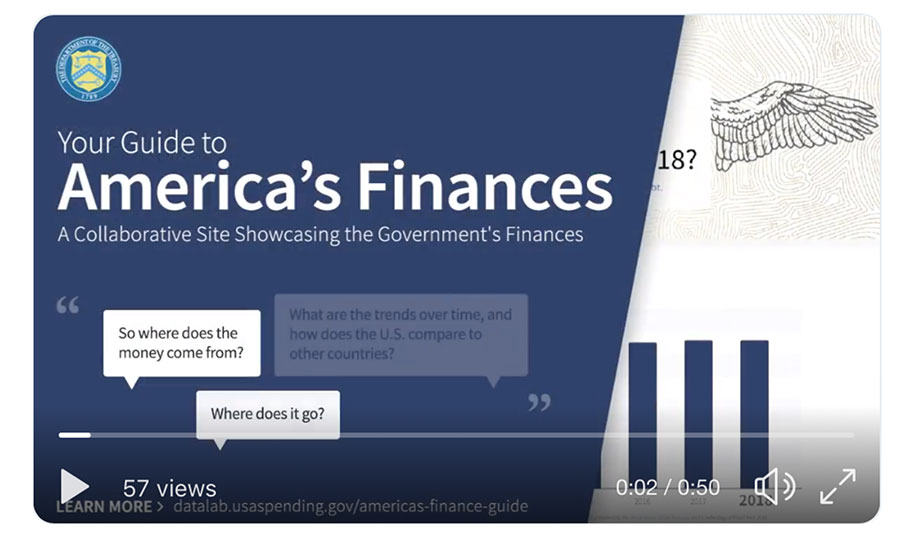

Transformation Stories
Explaining America's Finances:
Citizens Asked, Treasury Delivered

Your Guide to America’s Finances has arrived! The guide, designed with the help of several hundred citizens, provides a comprehensive digital overview of the trillions of dollars collected and spent by the federal government each year.
The release of the guide marked the first goal completed in the The Future of Federal Financial Management’s effort to strengthen financial reporting.
Citizen-Driven Design

Credit: St. Louis Federal Reserve Bank Inside the Economy Museum
Your Guide for America’s Finances was developed using human-centered design, an approach that develops solutions to problems by involving the user perspective in all steps of the problem-solving process.
Sharing information with citizens about federal finances is not new. For years, a citizen’s guide has been included in the Financial Report of the U.S. Government, which is released each year by Treasury.
But was the guide as helpful as it can be? In searching for information about federal financial information, few citizens knew where to look, and those who found it often were overwhelmed and confused. As one guide designer said, “It was written for accountants.”
“To create a user-friendly guide, we knew we needed to talk with citizens and find out how they like to receive information, and what they’re most interested in learning about,” said Justin J. Marsico, Fiscal Service Product Manager for Research and Analytics.
So interview teams went to Washington, DC’s National Mall, the Inside the Economy Museum at the St. Louis Federal Reserve Bank and the Money in Motion Exhibit at the Philadelphia Federal Reserve Bank, where thousands of citizens visit each year.
The teams interviewed hundreds of volunteer participants, and worked closely with them throughout the design process to explore the best ways to present complex information.
What Do Citizens Want?
During interviews, most citizens made clear that understandable graphs were needed, backed with explanations. They prefer plain language and simple, clear presentations of core concepts that allowed them to drill down if they wanted to learn more. Most said they got their information online, often on their phones. And sources mattered. Many felt the information they received on social media can be skewed or incomplete.
“Treasury is viewed as a trusted brand by those interviewed,” said Mr. Marsico. “People view it as a source of objective data and facts.”
Citizens wanted to understand where federal funding comes from, and where the money is spent. Many wanted a simple explanation of the difference between the federal deficit and the debt.
From concept to testing, citizens were engaged in the design process.
Using the Guide
The guide debuted on April 15, and traffic is up at its home in the Fiscal Service Data Lab.
The guide is divided into four parts: revenue, spending, deficit, and debt. Using animated graphs, users can find out where federal funding comes from, and learn where the money is spent. Terminology explanations are available throughout. Data can be downloaded, allowing for customized research. Users can also ask questions and post feedback on the guide, allowing for continuous improvement.
“The layout is key - it’s intuitive and helps me down each of the money paths while explaining what it means to me and my government. They did a great job explaining the complexities of government spending and providing layers of information so I can dig deeper into areas I find interesting. This is long overdue,” said Tom, a cyber-security expert from New Jersey.
“Engaging citizens in the process was exciting and eye-opening,” Mr. Marsico said. “This truly is a citizen’s guide. We heard from students who needed help writing papers to seasoned budget analysts. Your Guide to America’s Finances has something for everyone.”
Learn More:
Visit Your Guide to America's Finances.
Dig deeper by exploring Treasury's DataLab.
Previous Transformation Stories

Paying the Coast Guard After the Shutdown: 44,000 Paychecks, 48 Hours
When the shutdown ended on January 25, 2019, Treasury’s Bureau of the Fiscal Service made sure that 44,000 overdue salary payments were delivered to Coast Guard personnel by Monday morning.
Read Story
We call it data visualization.
For citizens, it's eye opening.
"With the DATA Act, we can now identify the geographic location of grants and combine that data with employment and census data to evaluate the true impact of our agency's programs."
Read StoryLast modified 05/25/23

